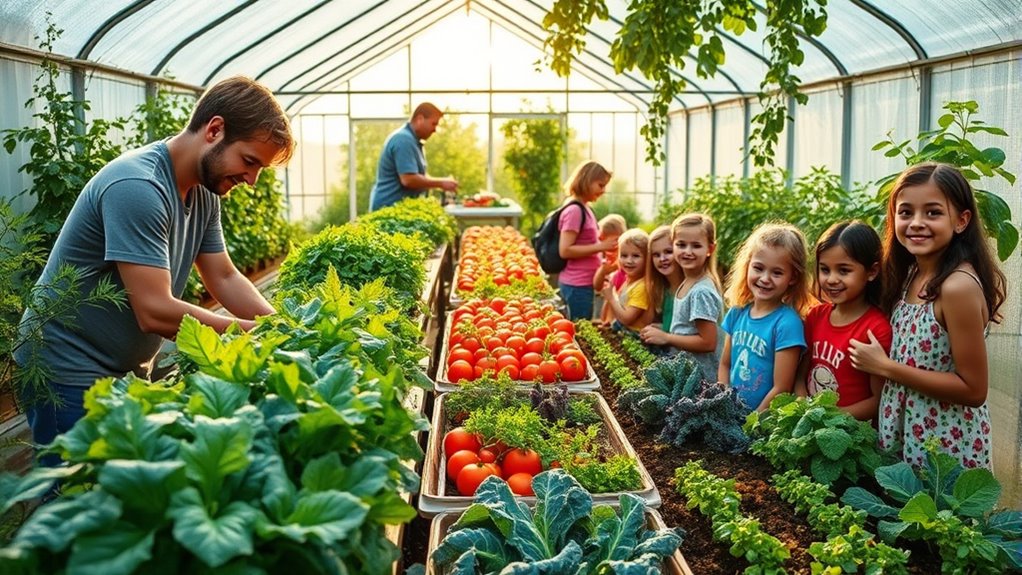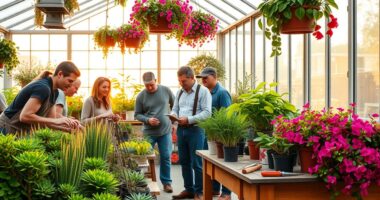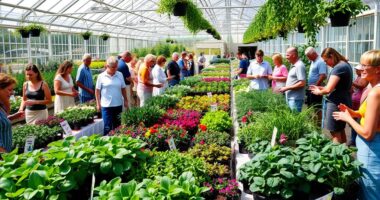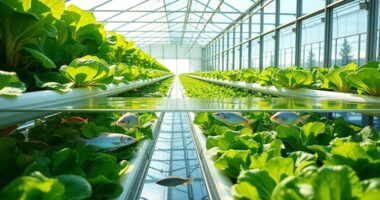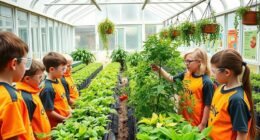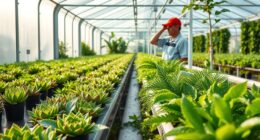A community greenhouse boosts local food access by providing fresh, healthy produce directly within your neighborhood. It uses sustainable farming techniques like composting, water conservation, and vertical gardens to maximize limited space and reduce environmental impact. By involving residents in farming activities and offering workshops, it encourages community participation and ownership. This local approach shortens supply chains and fosters social connections, showing how urban agriculture can make a real difference—discover more about this impactful transformation.
Key Takeaways
- The greenhouse provides fresh produce directly to nearby markets and kitchens, increasing local food availability.
- It employs sustainable farming techniques, ensuring consistent, eco-friendly crop production for the community.
- Urban farming strategies like vertical gardens maximize space, making food production accessible in limited urban areas.
- Community workshops and engagement foster shared knowledge, encouraging residents to grow and access more local food.
- The greenhouse serves as a model for sustainable urban agriculture, inspiring replication and expanding local food access efforts.

When the community greenhouse opened its doors, it immediately began transforming local food access. This innovative space serves as a hub for sustainable farming practices within the city, proving that urban agriculture can be both efficient and impactful. As you step inside, you realize that this greenhouse isn’t just about growing vegetables; it’s about creating a resilient food system that benefits everyone. By utilizing sustainable farming techniques, the community greenhouse minimizes environmental impact while maximizing yield. You see how composting, water conservation, and organic pest management are integrated into daily operations, demonstrating a commitment to ecological health. This approach not only produces fresh, healthy food but also educates visitors about environmentally responsible farming methods.
Urban agriculture, once seen as a niche activity, now takes center stage in this community. The greenhouse creates opportunities for residents to participate in growing their own food, regardless of space limitations. You notice how small plots and vertical gardens are used to optimize limited space, making urban agriculture accessible to many. This setup encourages local residents to get involved, whether they’re seasoned gardeners or newcomers. The community greenhouse acts as a catalyst for social cohesion, bringing together people from diverse backgrounds united by a shared goal: improving food security. It’s inspiring to see neighbors exchange tips, seeds, and harvests, fostering a sense of collective ownership and pride.
The impact on local food access is tangible. The greenhouse supplies fresh produce directly to nearby markets and community kitchens, reducing reliance on distant suppliers. This short supply chain means food reaches people faster and fresher, which is especially vital in underserved neighborhoods. Plus, by promoting sustainable farming, the greenhouse helps lower transportation emissions, contributing to a healthier environment. You realize that this model can be replicated elsewhere, showing that urban agriculture doesn’t have to be confined to rural areas. It’s a powerful tool for cities aiming to build sustainable, self-sufficient communities. The greenhouse also hosts workshops and training sessions, empowering residents to adopt sustainable farming practices in their own yards or community plots.
Additionally, integrating environmentally responsible farming methods further enhances the greenhouse’s sustainability and community impact. Seeing all this, you understand that the community greenhouse isn’t just about growing food—it’s about transforming the very fabric of urban living. It proves that sustainable farming and urban agriculture can work hand-in-hand to create a more equitable, resilient, and greener future. Through its example, you’re inspired to support or even start similar initiatives, knowing that small changes in how we grow food can lead to big improvements in local food access and community well-being.
Frequently Asked Questions
How Is the Greenhouse Funded and Sustained Long-Term?
You secure the greenhouse’s funding through grant funding from local organizations and government programs, guaranteeing initial setup costs are covered. To sustain it long-term, you build strong community partnerships that encourage donations, volunteer support, and ongoing funding. These collaborations foster shared responsibility, keeping the greenhouse operational and productive. Regular grant applications and community engagement ensure resources stay replenished, making sure the greenhouse continues to serve local residents effectively.
What Crops Are Most Successfully Grown in the Greenhouse?
You might think traditional crops thrive here, but surprisingly, leafy greens, herbs, and cherry tomatoes excel in the greenhouse. Thanks to hydroponic systems, you get rapid growth and high yields, while effective pest management keeps everything healthy without chemicals. These crops flourish because they’re well-suited for controlled environments, proving that even in a community greenhouse, you don’t need dirt to grow great food.
How Does the Greenhouse Involve Local Schools or Youth Programs?
You get involved in the greenhouse through student involvement and educational partnerships. Local schools often participate by organizing field trips, planting days, and hands-on gardening activities, which foster a sense of ownership and learning. These collaborations not only educate youth about sustainable agriculture but also empower them to contribute actively to the community’s food system. Your engagement helps create a vibrant, educational space that nurtures future farmers and environmentally conscious citizens.
Are There Volunteer Opportunities for Community Members?
Surprisingly, yes, there are volunteer opportunities for community members. You can get involved through community involvement and volunteer coordination, helping with planting, maintenance, or educational programs. It’s a great way to give back and learn about sustainable farming. Ironically, while many benefit from the greenhouse’s produce, your hands-on help guarantees its success. Your participation truly makes a difference, strengthening local food access and community bonds alike.
How Does the Greenhouse Reduce Food Waste in the Community?
You can reduce food waste by practicing composting and utilizing edible landscaping around the greenhouse. Composting turns food scraps into nutrient-rich soil, cutting down waste and supporting healthy plant growth. Edible landscaping encourages growing vegetables and herbs in public spaces, minimizing waste from over-purchasing and encouraging reuse. These practices help the community manage food waste effectively, promote sustainability, and make certain more locally produced food is enjoyed rather than wasted.
Conclusion
As you walk through the community greenhouse, you see hope sprouting with every leaf and every smile. It’s a shining beacon, a green heartbeat pulsing life into the neighborhood. This isn’t just about plants; it’s about growing stronger bonds and nourishing bodies. Together, you help turn a simple space into a lush garden of opportunity, where food flows freely and community roots run deep. In this greenhouse, everyone’s future blooms brighter.
